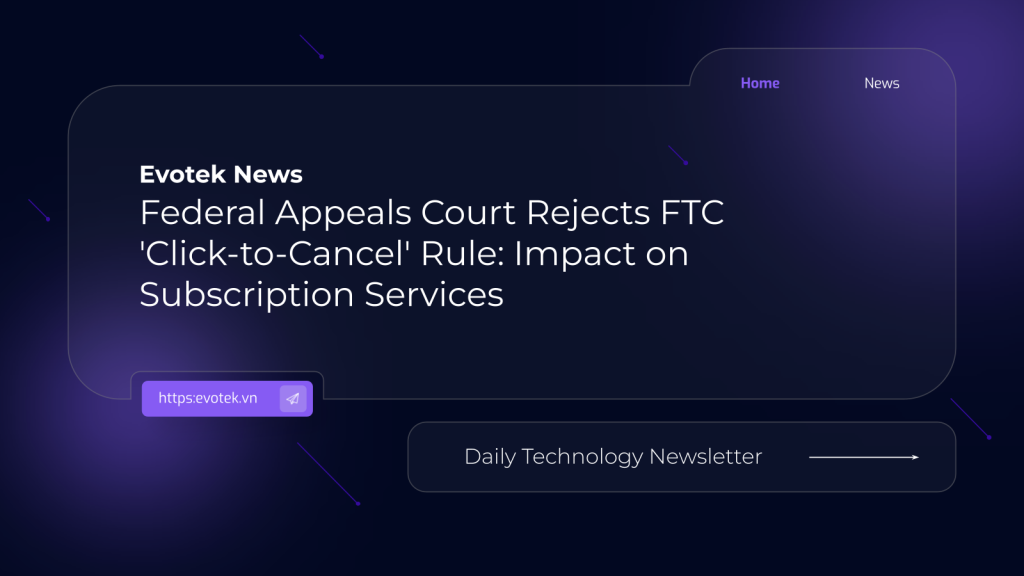A significant development in consumer protection law unfolded today as a federal appeals court invalidated the Federal Trade Commission’s (FTC) “click-to-cancel” rule. This regulation aimed to simplify the process of canceling subscription services, requiring companies to make it as straightforward as signing up. The rule, initially set to become effective on July 14, was struck down by the U.S. Court of Appeals for the 8th Circuit.
In a unanimous decision, a three-judge panel determined that the FTC, under the Biden administration and then-Chair Lina Khan, failed to adhere to the comprehensive rulemaking procedures mandated by U.S. law. While expressing sympathy for the FTC’s underlying objective of preventing unfair and deceptive practices in “negative option marketing,” the court found the procedural deficiencies to be “fatal” to the rule’s implementation.
Understanding the Court’s Decision
The court acknowledged the widespread issue of consumers finding themselves “unwittingly enrolled in recurring subscription plans,” often continuing to pay for unwanted products or services due to complex cancellation hurdles. Last year, the FTC had updated its 1973 Negative Option Rule to address this, adding requirements for clear disclosure of material terms, explicit consumer consent, and a simplified cancellation mechanism.
A central point of contention was the FTC’s obligation to conduct a preliminary regulatory analysis for any rule estimated to have an annual economic effect of $100 million or more. Initially, the FTC’s Notice of Proposed Rulemaking (NPRM) claimed the rule would not reach this threshold. However, an administrative law judge later concluded that the rule’s compliance costs would indeed surpass $100 million, unless businesses spent minimal hours on professional services. Despite this finding, the FTC proceeded without the required preliminary analysis, issuing only the final regulatory analysis alongside the final rule.
The judges decisively rejected the FTC’s arguments that the law did not necessitate this preliminary analysis later in the process, or that any error was harmless. The court emphasized that the statutory language, “shall issue,” unequivocally requires a separate preliminary analysis for public review and comment whenever the $100 million threshold is met following a notice of proposed rulemaking.
Industry Challenges and Procedural Due Process
Numerous industry groups and businesses, including major cable companies, had filed lawsuits against the FTC in various federal circuit courts. These cases were consolidated at the 8th Circuit, where Circuit Judges James Loken, Ralph Erickson, and Jonathan Kobes presided over the decision.
The appellate panel highlighted that the absence of a preliminary analysis deprived petitioners—the industry groups and businesses—of adequate time to assess and contest the FTC’s findings. This meant they lacked a proper opportunity to evaluate the Commission’s cost-benefit analysis of alternatives, a critical component of the preliminary analysis not typically required in the final version. The court noted that the FTC’s discussion of alternatives in its final analysis was “perfunctory,” briefly mentioning only two options: terminating the rulemaking or limiting its scope to in-person or mail-based negative option plans.
The 8th Circuit’s ruling warned that allowing such tactics could “open the door to future manipulation of the rulemaking process.” It suggested that furnishing an unrealistically low initial estimate of a rule’s economic impacts could enable agencies to take “procedural shortcuts,” thereby limiting public engagement and substantive analysis of a rule’s potential effects from the outset.
Political Divide and Future Implications
The FTC’s original proposal, introduced in March 2023, was approved by a narrow 3-2 vote in October 2024, with Republican Commissioners Melissa Holyoak and Andrew Ferguson voting against it. Commissioner Holyoak, in her dissenting statement at the time, expressed concerns that the rule was overly broad and might not withstand legal scrutiny. She also suggested it was a “back-door effort at obtaining civil penalties” across industries utilizing negative option marketing.
The “click-to-cancel” rule was initially championed by then-Chair Lina Khan, who stated, “too many businesses make people jump through endless hoops just to cancel a subscription. The FTC’s rule will end these tricks and traps, saving Americans time and money. Nobody should be stuck paying for a service they no longer want.”
This court decision marks a significant setback for the FTC’s efforts to simplify subscription cancellation processes for consumers. While the court acknowledged the consumer need for easier cancellation, its ruling primarily underscores the importance of strict adherence to established administrative procedures and regulatory analysis in the rulemaking process.

 日本語
日本語 한국어
한국어 Tiếng Việt
Tiếng Việt 简体中文
简体中文